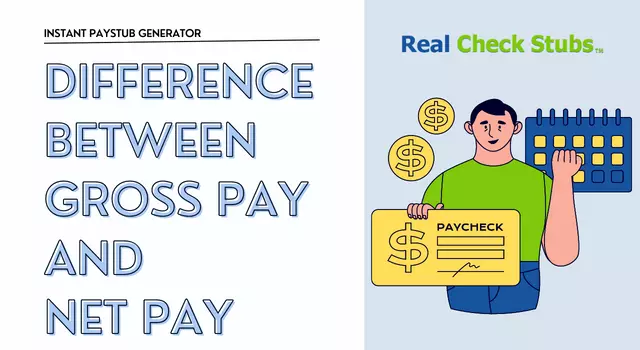Gross Pay vs Net Pay On A Pay Stub - What's The Difference?
Both employers and employees have to make important calculations when it comes to payroll. After all, everybody wants to know how much they’re spending on salaries or how much they’re getting paid.
And while these financials are very, very important, being accurate in calculating payments is far from easy.
Whether you’re an employer or an employee, you need to acquaint yourself with two important terms – gross pay and net pay. They signify different things and having a good understanding about both concepts will lead to much better financial accountability.

What’s the Difference Between Gross and Net Pay?
The simple definition of gross income is the earnings of an individual before taxes and other kinds of deductions are applied. Hence, this one is a larger sum than net pay – the amount of earnings that a person will receive after the payment of taxes and deductions.
Very often, gross pay is the amount that will be listed in a job ad. And because of that fact, employees can easily mistake it for the amount they’ll end up receiving each month (or however often they’re getting paid).
Net pay is often called “take home pay” because it is the actual sum employees receive. The difference between the two will depend on location, the field that the respective company operates in and the nature of additional deductions (more on those in the coming sections of the guide).
As a general rule of thumb, information about both types of payments is featured in an employee’s paystub. Having such a salary breakdown gives workers more clarity on how much they’re actually making and what percentage of their earnings goes to cover mandatory federal expenses and other deductions.
How Is Gross Pay Calculated?
If you are an employer who is dealing with salary calculations for the very first time, you may feel a little bit lost.
So, how exactly do you calculate gross pay? Is there a formula to simplify the process? The answer depends on how your employees are being paid. In order to make an accurate calculation, you’ll need to approach salaried and hourly payments in a different way.
Formula for Salaried Workers
The calculation can be made if you know the number of pay periods and the annual salary of an individual.
Pay periods can be as follows:
- Weekly (52 pay periods per year)
- Bi-weekly (26 pay periods per year)
- Twice monthly (24 pay periods per year)
- Monthly (12 pay periods per year)
For most companies, a monthly payment will be the most common scenario.
So, a worker who makes 50,000 dollars per year and is paid every month will have a gross income as follows:
50,000 / 12 = 4,166.67 dollars
Note: If workers earn commissions and bonuses, these amounts are added to the gross pay for the respective pay period. The sum of the salary and the bonus is the one to consider as gross income.
Formula for Those Receiving Hourly Payment
The formula for people who are getting paid on an hourly basis is also a fairly simple one.
In order to calculate the gross pay, you will need to multiply the number of hours completed during the respective pay period by the hourly rate.
Let’s say Michael earns 30 dollars per hour and has worked 160 hours over the course of a month. The gross income for that month is going to be:
30 x 160 = 4,800 dollars
If people work overtime over the course of the period, you will need to multiply the number of overtime hours by the overtime rate. At the time of writing, this rate is 1.5 times the regular hourly rate that the worker earns.
Once again, commissions and bonuses are added to the base pay in order to calculate the gross amount for the respective worker and for the specific period.
Factors That Impact Net Pay
Now that you know the difference between gross and net pay, it’s easy to conclude that the second sum is going to be noticeably smaller than the first one,
The net pay is heavily dependent on location and taxation specifics. Multiple factors will affect the take-home amount a worker is going to receive:
- Federal income taxes: the federal income tax is dependent on the amount that a person earns. Luckily, the IRS has a tax estimator you can use to determine the withholdings to anticipate over the course of a pay period.
- State income tax withholdings: apart from federal taxes, there are local deductions to account for when calculating net income. Check out this 2023 guide for more information on the current state tax percentages.
- FICA contributions: these consist of the Social Security tax and the Medicare tax. The Social Security tax rate is 6.2 percent and for Medicare, the deduction is 1.45 percent. The employee’s contribution has to be matched by the employer.
- Health insurance premiums
- Retirement savings contributions: including 401(k) and other plans
- Wage garnishments
- Voluntary deductions: like life insurance and job-related expenses
How Is Net Pay Calculated?
In order to make an accurate net pay calculation, you will have to go through the following steps:
- Step 1 – Calculate the employee’s gross pay amount: in order to apply the deductions, you have to start with the right number for the respective pay period.
- Step 2 – Calculate voluntary pre-tax deductions: these are the ones you will need to apply first and they include health benefits, retirement contributions (like company-sponsored 401(k) plans), insurance premiums and others. These are always going to be pre-tax deductions so the order in which you make the calculations is very important.
- Step 3 – Calculate tax deductions: it’s now time to determine how much will go to federal and state taxes. Depending on where you live, there will be some differences in those numbers. Luckily, many kinds of payroll and pay stub software products can make such calculations automatically after you enter your location.
- Step 4 – Calculate other mandatory deductions: while voluntary contributions are pre-tax deductions, there are some withholdings you need to apply after calculating and deducting taxes from the gross pay. Wage garnishments, for example, are considered a post-tax deduction. Whenever an employee has a mandatory garnishment, you as the employer will receive an official notification. It will include information about the amount you will have to withhold before handing the respective employee their wage.
Where and How Can I Find Information about My Gross and Net Salary
As an employee, you should have a specific answer to the question what’s the difference between net pay and gross pay. The company’s HR department should be capable of answering any questions you may have on the topic.
We’ve already mentioned the fact that both gross income and net income information should appear on your paycheck stub for the respective period.
A well-constructed paystub should also give you the details about the deductions and their specific breakdown.
Important Information for Employers: How Do Gross and Net Pay Impact Employer Tax Contributions
If you live in a state where employers aren’t obliged to hand out paystubs, you can formally request information about your gross and net income. An employer is legally obliged to provide you with those details, as well as deduction information.
Information for Employers: Taxes and Net / Gross Payments
Those who run a business are probably wondering about the way in which gross and net salaries affect taxation.
Every employer in the US has a responsibility towards their workers when it comes to covering some of their taxes.
We have already discussed the fact that employers have to match employee contributions in terms of FICA deductions.
Employers also have to make an additional taxation contribution under the Federal Unemployment Tax Act (FUTA). The funds from this program are used to finance unemployment benefits programs. The calculation for FUTA is simple:
- Six percent of the first 7,000 dollars you pay out as gross wages per employee per fiscal year
In most states, an employer who pays unemployment taxes on time will receive a FUTA tax credit of 5.4 percent. This will significantly diminish the financial burden on the company.
The Importance of Understanding the Difference
Anyone who employs people in their business will need to understand the difference between gross and net pay.
Labor costs can be significant – in the service-based business field these expenses can reach as much as 50 percent of a company’s revenue. Because you are spending so much money on paying workers, you need to have a good understanding of the total amount, the deductions that are withheld and the sums that actually end up in a worker’s pocket.
Being financially-savvy can also help you build your trustworthiness and maximize employee engagement. Workers will often have questions about their income and what is being deducted from it. The ability to answer correctly and thoroughly will build trust and a good rapport with skilled laborers.
As an employee, you also need to be educated on financial matters pertaining to income and taxes. There are still people who mistakenly believe that their gross pay is the same as the money they take home. Such misguided beliefs will result in a ton of disappointment (at best). Lacking the knowledge about income and deduction calculations makes you vulnerable and even likely to accept work conditions that aren’t optimal for you.
And here’s one final important point that pertains to taxes. Every employee has to pay taxes on the income they earned over the course of the fiscal year. These calculations start with gross rather than net pay.
Keep in mind, however, that gross income and taxable income are not the same thing. Some income sources are not included in taxable income and this is one more thing you will need to keep in account when handling financials.
Gross and Net Pay in a Nutshell
The gross income is usually higher than net wages because it doesn’t account for taxes and other deductions. And while this sum looks attractive for marketing purposes (like attracting new employees to the company), it doesn’t provide an accurate idea in terms of take-home money.
While understanding the difference between the two wages is fairly easy, making the calculations to accurately estimate net pay from gross pay is not a simple task.
Many people will turn to accountants and financial advisors to make sense of the percentages and the order in which the calculations have to be made.
The good news is that software often comes to the rescue. High quality payroll solutions and pay stub generators can automate lots of the complicated mathematical steps that lead from accurate gross pay to accurate net pay.
When in doubt, look for a reliable software-based platform. If you are an employee, you can request such details from your company’s HR department. Having the raw numbers in your hands will make it much easier to double-check the details, consult another professional or run the digits through a calculator in order to make sense of your current income.
Kristen Larson is a payroll specialist with over 10 years of experience in the field. She received her Bachelor's degree in Business Administration from the University of Minnesota. Kristen has dedicated her career to helping organizations effectively manage their payroll processes with Real Check Stubs.

